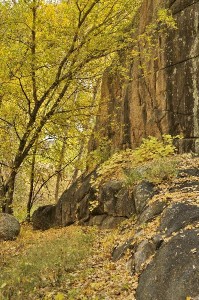A blustery stranger arrived unannounced on Friday. The day dawned clear like so many others. By 11 as I drove home from the college for a quick lunch, the unexpected guest had arrived, leaving the door open so that its forceful breath whipped up whitecaps on Watson Lake. Dust and leaves swirled in its powerful exhalations. Low clouds streamed over the rounded crests of the Bradshaw Mountains. Winter had suddenly returned to Arizona. By late afternoon, shadows and sunlight alternated in rapid succession as the clouds streamed past on the gale. I felt the urge to be out there with my camera, to capture the mood of this aeolian beast. Ironically, I was at the Highlands Center for Natural History giving a workshop on nature photography, my camera no more than a prop for demonstration. Soon rain pelted the windows, momentarily interrupting my talk. By the time I finished my workshop, clouds completely covered the sky; no gaudy Arizona sunset would appear this evening.
Rain lashed the bedroom windows in violent bursts during the night. Dawn brought cold temperatures and views of snow mantling the mountains around Prescott. The chilled breath of winter remained.
A teacher’s life, mine anyway, gives few hours of separation from work. Lessons have to be planned, papers graded, books chosen for the next term, feedback given to advisees on degree plans, and all the other trappings of an academic life attended to. Usually I resign myself to Saturday as a catch-up day.
But to a naturalist, that call of the wild is insistent, nagging, demanding. The window beckons more strongly than does the computer screen. The words of Henry David Thoreau come to mind:
“Live in each season as it passes; breathe the air, drink the drink, taste the fruit, and resign yourself to the influence of the earth.”
― Henry David Thoreau, Walden, or Life in the Woods
Finally, at 4:30, knowing that dusk will descend all too soon, I abandon the phosphors of the monitor and head off toward Granite Creek, no objective in mind other than living deeply in the sense of the season, absorbing the messages that nature leaves us every day if only we stop to read them. Like Thoreau, I will resign myself to the influence of the earth.
Many of the towering cottonwoods that dominate the riparian area are holding on to their summer trappings, faded a bit by the early frosts, but still green. Yesterday’s winds ripped their weakening yellow leaves into blizzards of aerial flotsam that settled to the floor of the woods or collected in quiet pools in the creek.
For autumn color, I need to slip beneath the canopy, find the fallen leaves of Boxelder, varying shades of yellow, gold, rust, and pale green. The creek itself is dark, though rafts of bright leaves sent to earth by last night’s storm catch at each narrowing of channel, and golden tones of Velvet Ash in the understory echo in the reflections.
I cross the creek and follow a path of yellow leaves until I am at the base of a cliff, a dramatic counterpoint to the peaceful floodplain. A rounded shelf at the base of the cliff supports a tangle of grape that cascades down its sides. I feel suddenly like I am back in the mountains of Oregon, a dark fairyland of lush, deciduous delight. The piercing call of a flicker adds to the ambience.
I am struck once again by the connectivity of nature across the continent. Here I am under Fremont Cottonwoods, whose range follows watercourses through the arid Arizona deserts into Mexico, the Rio Grande through New Mexico, and way up into the Sacramento Valley of California, clear to the Sutter Buttes that I love so much. Right here I have seen Yellow-billed Cuckoo, a tropical bird that visits only long enough to raise its babies and glean hairy caterpillars from our trees, and wintering Hermit Thrushes, symbol to me of the humid Pacific Northwest. The Boxelders that add so much color to these woods are remnants of once-extensive deciduous forests that literally dried up as rising mountain ranges intercepted the bulk of the moisture moving inland off the Pacific Ocean; today the majority of its range is the interior of the continent in a vast swath from Houston to Calgary, from Wichita to Washington, DC.
Our plants, our animals—they link us across North America—as do our seasonal changes within the temperate zone. And as we connect emotionally with bits of biomes across the country, we feel the tugs of memory, of loved ones with whom we have walked through windrows of fallen leaves or through the gusts of wind that carry hints of sea salt. Even as tree buds harden their protective scales to await the frosts ahead and Acorn Woodpeckers put in long hours adding to their granaries that will hold them through the lean months, we are experiencing similar urges. It’s time to batten down the hatches, to drain the hoses and winterize the house so that we feel prepared for the return of this winter guest, no longer unexpected.
To resign ourselves to the influence of the earth, as Thoreau advises, is no retreat. It is a chance for renewal, a chance to experience the shifting pleasures of the sensual earth. An hour or two along Granite Creek was just the tonic I needed this weekend. My energies are renewed. I have inhaled the winter winds and found invigorating inspiration. To inspire is to live, and I hope my expiration date is far, far in the future.



